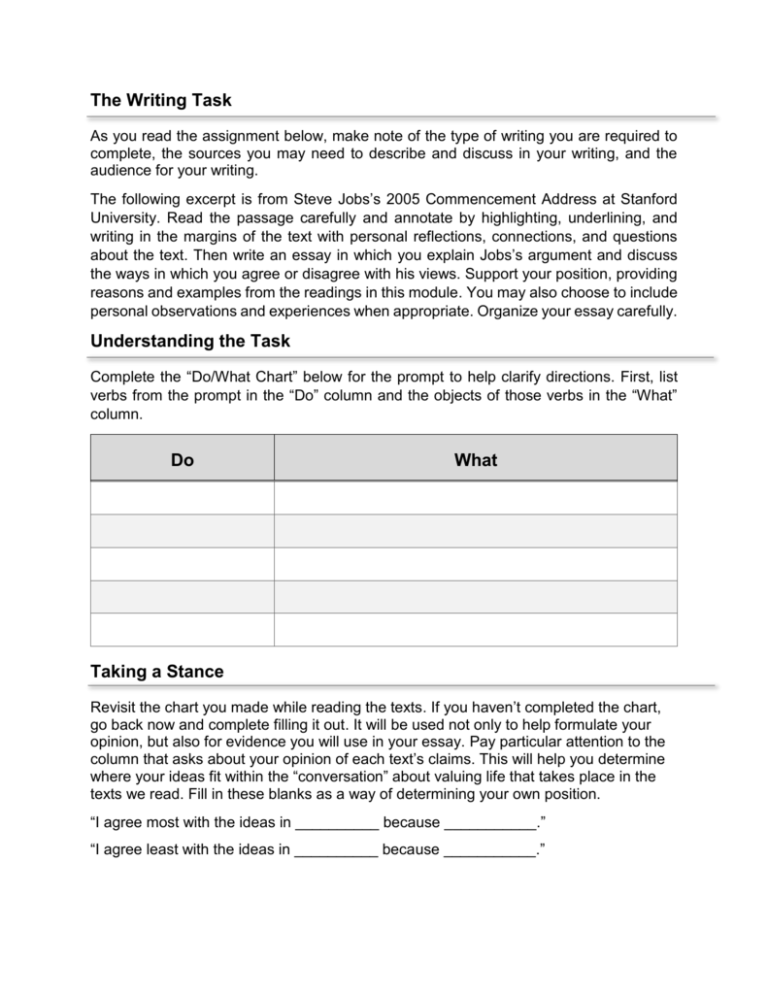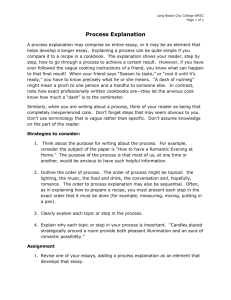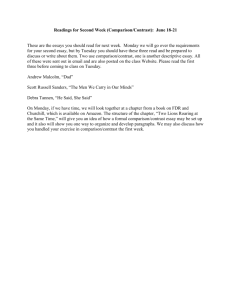The Writing Task
advertisement

The Writing Task As you read the assignment below, make note of the type of writing you are required to complete, the sources you may need to describe and discuss in your writing, and the audience for your writing. The following excerpt is from Steve Jobs’s 2005 Commencement Address at Stanford University. Read the passage carefully and annotate by highlighting, underlining, and writing in the margins of the text with personal reflections, connections, and questions about the text. Then write an essay in which you explain Jobs’s argument and discuss the ways in which you agree or disagree with his views. Support your position, providing reasons and examples from the readings in this module. You may also choose to include personal observations and experiences when appropriate. Organize your essay carefully. Understanding the Task Complete the “Do/What Chart” below for the prompt to help clarify directions. First, list verbs from the prompt in the “Do” column and the objects of those verbs in the “What” column. Do What Taking a Stance Revisit the chart you made while reading the texts. If you haven’t completed the chart, go back now and complete filling it out. It will be used not only to help formulate your opinion, but also for evidence you will use in your essay. Pay particular attention to the column that asks about your opinion of each text’s claims. This will help you determine where your ideas fit within the “conversation” about valuing life that takes place in the texts we read. Fill in these blanks as a way of determining your own position. “I agree most with the ideas in __________ because ___________.” “I agree least with the ideas in __________ because ___________.” Now that you have an idea about what you agree with it is time to formulate a claim or thesis. Your essay’s thesis is the primary claim that you will be making about valuing life. There are several attributes of claims that form the basis of successful essays. A good claim is 1. Clear: Your reader should easily understand your essay’s claim. 2. Compelling: The claim should be interesting to your reader and should make the reader want to read your entire paper. 3. Complex: A claim that is too simple will not engage your reader and won’t contribute significantly to the “conversation” about the topic. 4. Contestable: Any claim that no one would disagree with is unlikely to be of interest to your reader. Try writing a few claims for your essay. It might be helpful to think of your claim as a response to a specific question whose answer matters to the essay’s audience. Generating Evidence to Support Your Claims Informal writing is a useful tool for helping you get ready to do more formal writing, as with the writing assignment above. To help you construct and support your claims for this essay, you should revisit some of the informal writing we have done this unit such as quickwrites, annotations, and reflections on specific texts. The text comparison chart, in particular, will help you to identify evidence you can use in your paper. As you review the evidence you’ve already generated through your quickwrites, annotations, and chart, consider the following questions: 1. How closely does this piece of evidence relate to the claim it is supposed to support? 2. Is this piece of evidence a fact or an opinion? Is it an example? 3. If this evidence is a fact, what kind of fact is it (statistic, experimental result, quotation)? 4. If it is an opinion, what makes the opinion credible? 5. What makes this evidence persuasive? 6. How well will the evidence suit the audience and the rhetorical purpose of the piece?










